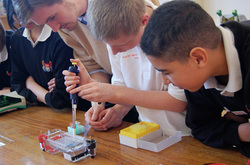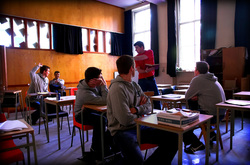Student - Student Relationships

Student to student relationships go beyond ensuring that we all are "getting along." Relationships can make a big difference in how safe students feel in our classrooms. Do students feel comfortable enough to let down their guard and join us in this sometimes risky business of learning?
One way teachers can work to create safe classroom environments is by allowing opportunities for and nurturing student to student relationships. The research is clear that students can be powerful motivators in their peers' learning. As educators, we need to continually find ways for students to get to know each other as peers and collaborative problem-solvers.
Ways to build and strengthen student to student relationships:
- Start the year out with activities that allow students to share a bit of themselves. Even old-fashioned ice-breakers can do the trick.
- Incorporate meaningful and well-planned group-work into class instruction (Lotan 2003).
- Have students work in "home" or "base" groups, set groups that allow them to establish a rapport and norms (Johnson 1994).
- Allow students time to interact with each other in organized and more free form ways.
Cooperative Base Groups
Johnson, D.W., R.T. Johnson & E. Holubec (1994). The New Circles of Learning. Alexandria, VA: Association for Supervision and Curriculum Development. 16 – 30.
Johnson & Johnson’s article discusses the idea of cooperative base groups and how they help students help each other stay accountable and successful. They describe two types of base groups; class base groups and school base groups. In both types, students check in with each other at least once a day to aide in academic, routine and personal support tasks. The article goes on discuss group size, methods for choosing groups, length of group life and using different combinations of cooperative learning group types.
Johnson & Johnson’s article discusses the idea of cooperative base groups and how they help students help each other stay accountable and successful. They describe two types of base groups; class base groups and school base groups. In both types, students check in with each other at least once a day to aide in academic, routine and personal support tasks. The article goes on discuss group size, methods for choosing groups, length of group life and using different combinations of cooperative learning group types.
Meaningful Group-Work
Lotan, R. (2003). Group-worthy tasks. Educational Leadership, 60(6).
Equity & Group-Work
Cohen, E., Lotan, R., Scarloss, B., Arellano, A. (1999). Complex instruction: equity in cooperative learning classrooms. Theory into Practice, 38(2).
School Communities: Including Everyone
Here is a helpful online article by Dr. Paula Kluth, "consultant, teacher, author, advocate, and independent scholar" in which she lists five ways schools can work to foster an disability-inclusive community.
http://www.paulakluth.com/articles/relationships.html
http://www.paulakluth.com/articles/relationships.html
Edutopia Blog Posts: Creating School Community & Building Relationships
Below is a link to a Edutopia blog post by Bob Lenz (chief executive officer and co-founder of Envision Schools). See what he and others have to say about creating school-wide communities.
http://www.edutopia.org/envision-schools-learning-community-respect
And here Lenz blogs specifically about relationships in the classroom:
http://www.edutopia.org/envision-schools-relationships
http://www.edutopia.org/envision-schools-learning-community-respect
And here Lenz blogs specifically about relationships in the classroom:
http://www.edutopia.org/envision-schools-relationships
Edutopia Video: The Value of Social and Emotional Learning
This link to Edutopia is a video-interview with Daniel Goleman, author of Emotional Intelligence. Goleman speaks of the shown value of social and emotional programs and focuses in schools.
http://www.edutopia.org/daniel-goleman-social-emotional-learning-video
http://www.edutopia.org/daniel-goleman-social-emotional-learning-video



